Text
Aziz + Cucher

Aziz + Cucher have been collaborators since 1992, after meeting as graduate students at the San Francisco Art Institute. They are now Fine Arts faculty at Parsons School of Design in New York and are based in Brooklyn. Their interdisciplinary practice spans video, photography, screen-printing, textiles, sculpture, and digital animation. Their work explores the fluid and undefined boundaries of identity, often blending reality and fiction to reveal the pathologies of globalization, post-human conditions, and intersections of the social, biological, and technological. They aim to express the anxieties and expectations of contemporary life through visual poetics
Aziz + Cucher have exhibited at prestigious venues including the 46th Venice Biennale, MASS MoCA, the New Museum (New York), the San Francisco Museum of Modern Art, the Los Angeles County Museum of Art, the List Visual Art Center at MIT, the National Gallery of Berlin, and the Museo Nacional Centro de Arte Reina Sofia (Madrid). Their work is in public collections such as LACMA, SFMOMA, Fonds National d'Art Contemporain (Paris), Galería de Arte Nacional (Caracas), and the Museum of Contemporary Photography.

May - Dystopia, 1994-95 - C-Print, 50 x 40''
The image presented is a haunting visual exploration of identity, or rather the loss of it, reflecting a deep commentary on the effects of technology and societal norms on individuality. The photograph depicts a young person, adorned with a delicate floral crown that traditionally symbolizes innocence, beauty, and nature. However, this idyllic image is starkly disrupted by the eerie absence of facial features—eyes, nose, and mouth have been digitally erased, leaving a smooth, featureless expanse where a face should be. This unsettling alteration transforms the portrait into a powerful critique of anonymity and conformity in a technologically driven society.
I am inspired by Aziz + Cucher to explore different artistic mediums, blending them to express my ideas in new ways. Their focus on identity, especially under the influence of technology and societal pressures, pushes me to examine similar themes in my work. Their critique of globalization and its impact on individuality makes me reflect on how these forces affect my life. I am also drawn to how they use visual poetics to convey deep emotions, motivating me to incorporate symbolic elements into my creations. Their haunting imagery, like the faceless portrait in "Dystopia," inspires me to explore themes of anonymity and conformity in my work.
0 notes
Text
Essence of Summer: A Narrative in Triptychs (Final Project)

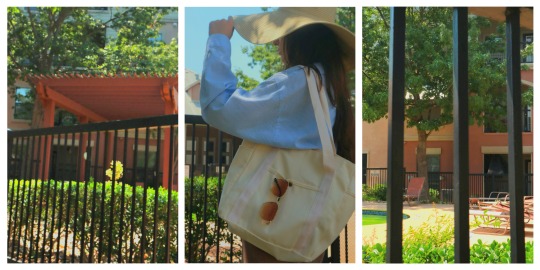


The purpose behind creating this work was to convey the essence of summer. I aimed to highlight different aspects of the season through symbols such as watermelon, sunglasses, and other iconic elements associated with summer. The choice to work with a summer theme stemmed from the fact that this is the first summer class I have ever taken, and I wanted to create something that would distinctly mark this experience. Each photograph chosen for the triptychs tells a story, capturing a moment in time. I intentionally maintained a consistent tone of saturated and warm hues throughout the images to evoke the vibrant and intense feeling of summer. By using triptychs, I was able to explore multiple perspectives within a single narrative, offering a more complex story than a single photo could convey.
Three of the works were taken outdoors in natural lighting, while one was captured indoors under lamp lighting. Each object in the photos was purposefully selected and arranged to fit the summer theme. To maintain consistency in angle and composition for the outdoor shots, I used a tripod, which also allowed me to include myself in the photos. Each triptych carries its own narrative: one featuring fruits and iced water conveys the refreshing relief that everyone seeks in the summer; another, by the pool, shows a girl ready to swim, only to find the pool closed with green water, symbolizing the unexpected disappointments summer can bring. The triptych with sunglasses against the sky captures the simple joy of basking in the sun, while the final one, with a fan, sunscreen, and watermelon, showcases the essentials of a typical summer day.
I drew inspiration from David Hilliard, known for his complex narratives that explore various themes and situations, from quiet moments of contemplation to scenes of heightened drama. I used his work as a guide, striving to translate my vision of summer into this project. My goal was to convey the sensations of summer—the heat, the challenges, and the joys—through small yet significant details. Each element was chosen to capture the essence of this season, focusing on the familiar experiences and objects that define summer for many of us.
Canon EOS M50 Mark II - Natural & Lamp lighting
5 notes
·
View notes
Text
GIFs

I created this GIF using sculpture clay from my sculpture class. I started with a piece of clay placed on the table, set my camera on a tripod, and began the shooting process. The lighting is provided by the lamp in my room. Although I tried my best, the camera's position shifted slightly, but overall, the images are consistent and flow smoothly. Initially, I planned to create an actual sculpture and show the progress, but I realized it would require too many photos. So, I stopped creating the human face midway and ended the GIF with the clay rolling out of the frame.
The transition from a static image to a GIF involves creating multiple frames that display quickly, creating the illusion of motion. This change affects how motion is perceived, as GIFs depict actions or processes over time, making the content more dynamic and engaging. While static images capture a single moment, allowing for deeper contemplation of that moment, GIFs add a narrative element, emphasizing repetition and continuous action. This shift can alter the emotional impact and interpretation of the content, making complex processes easier to understand and adding elements of storytelling or humor.
Canon EOS M50 Mark II - Lamp lighting
2 notes
·
View notes
Text
Final Work In-Progress
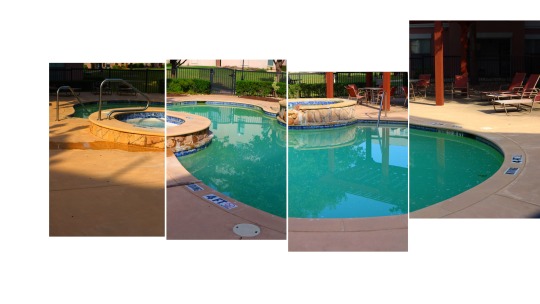
I am creating a series of triptych/grid/joiner photos that evoke the essence of summer for the audience. These images aim to capture the nostalgic experiences and feelings unique to summertime. This test shot evaluates my ability to capture multiple photos from the same scene and connect them. While this particular image may not be part of my final series, it features a swimming pool, which can also symbolize summer.
Canon EOS M50 Mark II - Natural lighting
0 notes
Text
10. Photography and AI
AI is poised to significantly transform photography and art, bringing positive and negative impacts. On the positive side, AI enhances creativity by providing artists with novel ideas and patterns from vast data analysis, pushing creative boundaries. AI increases efficiency by automating tedious tasks such as photo editing and color correction, allowing artists to focus more on their creative processes. AI also provides accessible tools that require less technical skill, enabling a broader audience to engage in artistic endeavors. Additionally, AI introduces new mediums for creative expression, such as generative art, and creates interactive experiences that can engage audiences in new ways. As Peter Morgan in FStoppers highlights, AI-generated images can take creativity to a new level, providing artists with tools they never had before.
However, the rise of AI in art and photography comes with challenges, particularly regarding authenticity and ethical concerns. As Morgan notes, "AI tools can be used to create images that are almost indistinguishable from real photographs," making it difficult to verify their authenticity and raising the potential for fake news and propaganda. This issue could be more problematic for photojournalism, which relies on the objectivity and trustworthiness of images. The challenge of distinguishing between AI-generated and real photographs could spread misinformation, undermining photojournalism's credibility and the principle that "the camera never lies." Furthermore, the visual appeal of AI-generated images might contribute to a decline in the quality of traditional photojournalism. Morgan warns, "AI's impact on photojournalism could be far-reaching, affecting the essence of how we perceive reality." Balancing these impacts requires establishing clear ethical guidelines, promoting human-AI collaborations, and ensuring AI tools enhance rather than replace human creativity.
0 notes
Text
9. Passage
"Passage," to me, represents the quiet, unnoticed moments that make up our lives, the continuous flow of time that moves forward while we are absorbed in our routines. It is the transition from one moment to another, each leading us through the journey of life, embodying the flow and continuity of our experiences. To capture "Passage" in a visual medium, I would focus on the subtleties of everyday life, emphasizing the serene yet constant movement of time. The imagery should evoke a sense of peace and reflection, allowing the viewer to appreciate the beauty in the mundane.
To express "Passage" through moving images, I would use soft, warm hues and natural light, especially during the golden hours of early morning or late afternoon, to create a calming atmosphere. Everyday objects suggesting movement and time would be featured. The pacing would be slow and deliberate, letting each scene linger long enough for the viewer to absorb the details and feel the passage of time. Importantly, the videos would include the real sounds of those moments—rustling leaves, chirping birds, the ticking of a clock—rather than overlaying them with music, to capture the authentic ambiance of each scene. Through these visuals and natural sounds, "Passage" is shown as a gentle, continuous journey, reminding us to appreciate the quiet moments that often go unnoticed but are the essence of our existence.
I recorded these videos on an afternoon in my apartment complex, aiming to capture calming frames. I then connected them together to create a short clip.
Canon EOS M50 Mark II - Natural lighting
2 notes
·
View notes
Text
8. Glitch
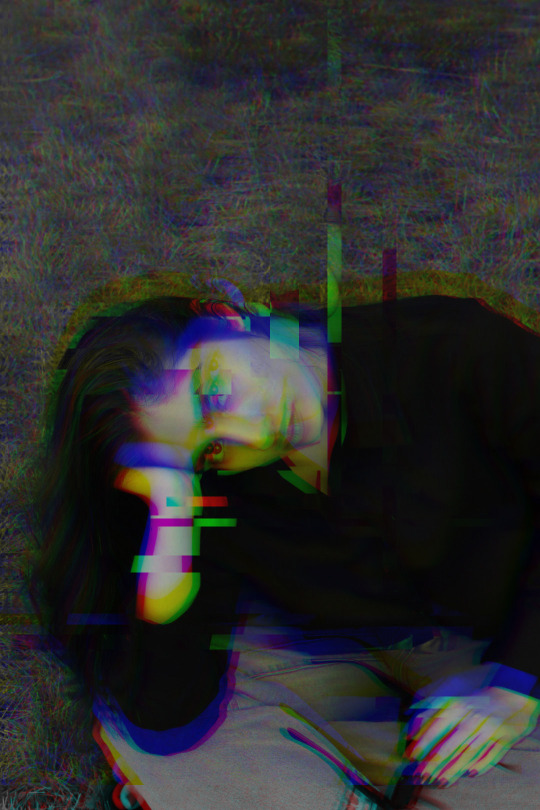
This photo shows a girl who looks like she is deep in thought, almost as if she's disconnected from reality. The muted colors make the picture feel more serious and sad. But the bright, colorful glitch patterns add a sense of hope. These colorful lines are like sparks of light in the darkness. They are not orderly, but they are there, showing that there is still hope and positivity that just needs to be organized.
Canon EOS M50 Mark II - Natural lighting
Artists:
Sabato Visconti's work stands out for its innovative use of digital glitches as artistic expression. He transforms the imperfections and errors in digital technology into striking visual art. By manipulating software and hardware malfunctions, Visconti creates pieces that challenge our perception of reality and the digital world. His approach highlights the beauty in the unexpected and the flawed, encouraging viewers to see glitches not as mistakes but as unique and compelling elements. This perspective not only redefines traditional notions of art but also reflects on the pervasive influence of technology in our lives.
Heitor Magno blends photography with digital manipulation to create dreamlike, otherworldly scenes that captivate and intrigue. His approach often involves layering images and playing with textures to produce a sense of depth and fantasy. Magno's work explores themes of identity, nature, and the subconscious, inviting viewers to immerse themselves in his imaginative worlds. His ability to merge reality with fiction through meticulous digital editing results in visually stunning and emotionally resonant artworks.
1 note
·
View note
Text
7. Joiners, Triptych, Grid
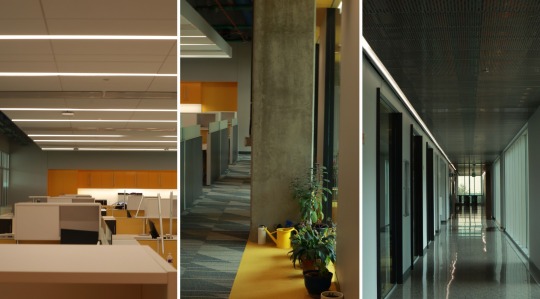
This triptych/grid was created using three photos I took in one of the buildings on the UTD campus. Each frame captures a different portion of that area. The photo on the right shows the hallway, the middle photo features the plants right behind the glass visible in the hallway photo, and the photo on the left depicts the interior next to the plants, where the cubicles are located. The yellow cupboards in both the middle and left photos demonstrate the connection between them, highlighting how they depict the same place from different perspectives. These three photos collectively present a cross-section of this building, moving from left to right to show three distinct perspectives.
Canon EOS M50 Mark II - Natural lighting
1 note
·
View note
Text
6. What Is Video Art?
Video art uses video technology to create visual and auditory experiences. Unlike traditional film, which often follows a narrative structure and aims to entertain or inform, video art focuses on exploring and expressing artistic concepts and emotions. It can range from short clips to long installations and be displayed on screens, projected onto surfaces, or integrated into physical environments. Video art introduces time, motion, and sound elements, creating a dynamic experience that conveys complex narratives more vividly than still imagery. While still images capture a single moment, video art explores the progression of events, changes in emotion, and the passage of time. This medium allows artists to manipulate these elements to create immersive and thought-provoking experiences. The interpretation of video art is fluid and subjective. Its continuous nature means viewers might notice different aspects or feel different emotions each time they experience the work. The meaning of video art can change with context, time, and audience.
Nam June Paik is often considered the father of video art. His innovative use of video technology in the 1960s and 1970s revolutionized the art world. Works like "TV Buddha" juxtapose modern technology with traditional symbols, questioning the relationship between media and spirituality. Paik focused on the intersection of technology and culture, often using humor and irony. Bill Viola is known for his emotionally intense video installations that explore themes of human experience, such as birth, death, and consciousness. His work "The Passing" delves into the pain of loss and the mourning process, using slow-motion and high-definition video to create a profound sensory experience. Viola's work resonates with me due to its emotional depth and use of video to explore profound human experiences. While I appreciate Paik's pioneering contributions, some of his works feel less emotionally engaging. However, I still value Paik's innovative approach and influence on the medium. The work of artists like Nam June Paik and Bill Viola demonstrates the diverse ways video art can convey meaning and provoke thought.
0 notes
Text
5. Alternate Reality
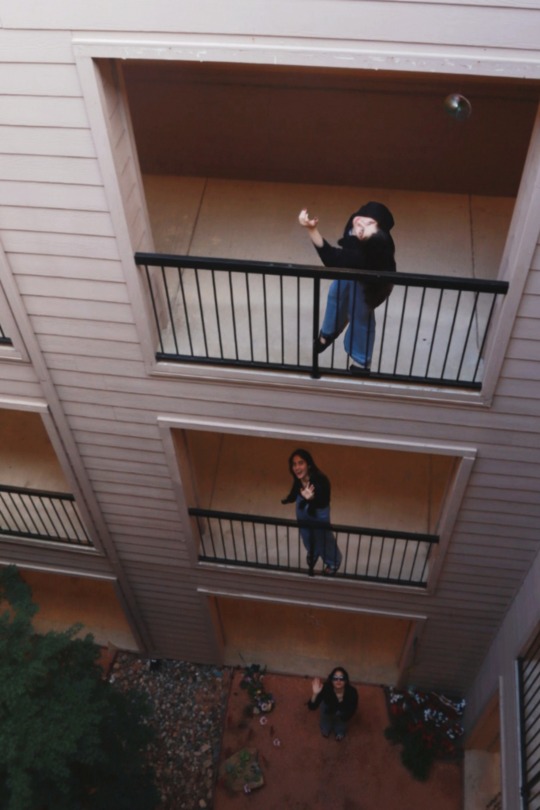
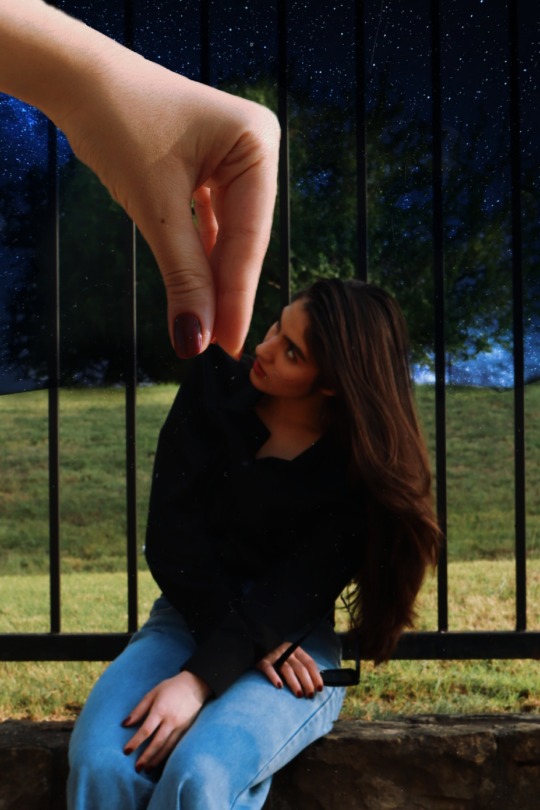


In these surrealist photos, I tried to use minimal editing to make them look as realistic as possible. For the photo on the left, I took three different pictures of myself with the camera planted in one spot and went to different floors. Then, I combined the three images and added an effect on top to blend them more. Now, it looks like three of me exist.
In the photo on the right, I took two photos in the same location with the same lighting and then edited the hand in it. The background has a night sky photo that I found; it is blended into the sky. Finally, I edited the overall effect to blend everything together.
Canon EOS M50 Mark II - Natural lighting
3 notes
·
View notes
Text
Reading 3: Erik Johansson, Full Moon Service, 2017

Erik Johansson, a retoucher and photographer, skillfully uses surrealism in his work by combining multiple images to create realistic yet fantastical scenes. His work often plays with perception, blending the ordinary with the extraordinary in a seamless manner. One notable piece, "Full Moon Service" (2017), exemplifies this technique. In "Full Moon Service," Johansson depicts a whimsical scene where a service van appears to be repairing the moon, treating it like a streetlight. This image uses surrealism by taking a familiar object, the moon, and placing it in an unexpected context, challenging our perception of reality. The moon, an astronomical body, is symbolized as a tangible object that can be serviced Johansson's particular attention to detail ensures that each element of his composite images aligns perfectly, creating a believable yet dreamlike world. The symbolism in his work often evokes a sense of wonder and curiosity, prompting viewers to reconsider the boundaries between reality and imagination. Through his surrealistic approach, Johansson invites us to explore new perspectives and engage with the world more imaginatively and thoughtfully.
0 notes
Text
EX. All about LIGHT
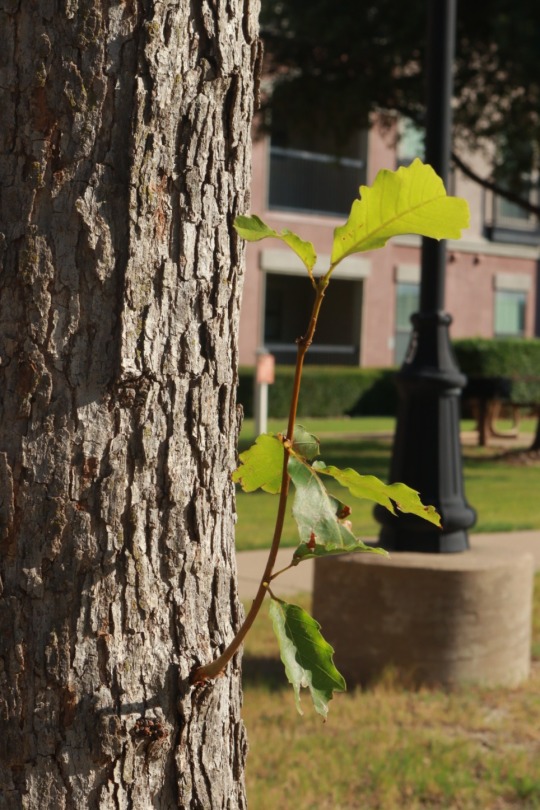



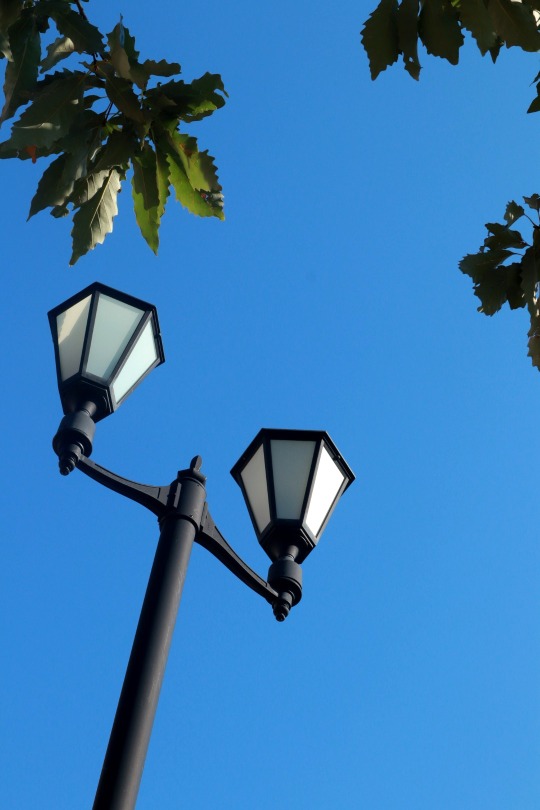
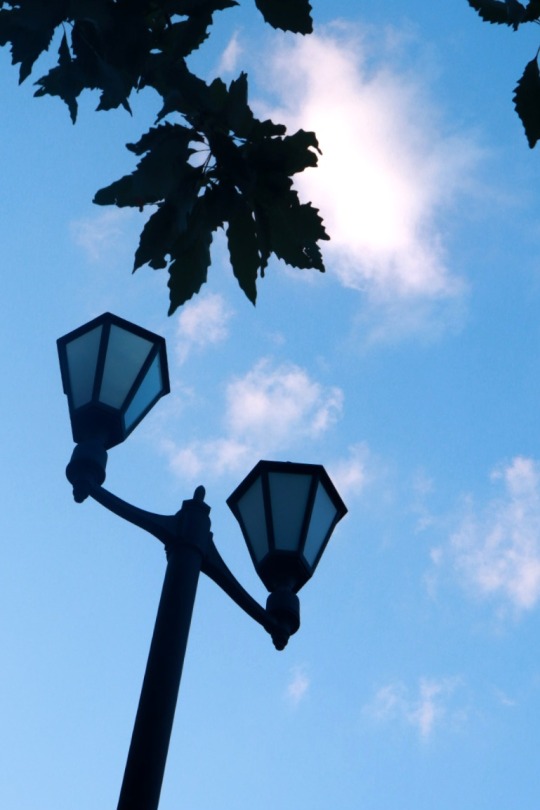
The lighting varied throughout the day, creating a different feeling in each photo. The first photo has bright, white tones; the second photo has warmer tones; and the third photo has cooler tones. The shutter speed required changed significantly based on the time of day. Another noteworthy aspect is how the shadows changed throughout the day. The aperture increased as the day grew darker, with the least shadowing in the evening. Overall, the theme of the photos shifted with the changing hours of the day.
Canon EOS M50 Mark II - Natural lighting
1 note
·
View note
Text
4. Photomontage
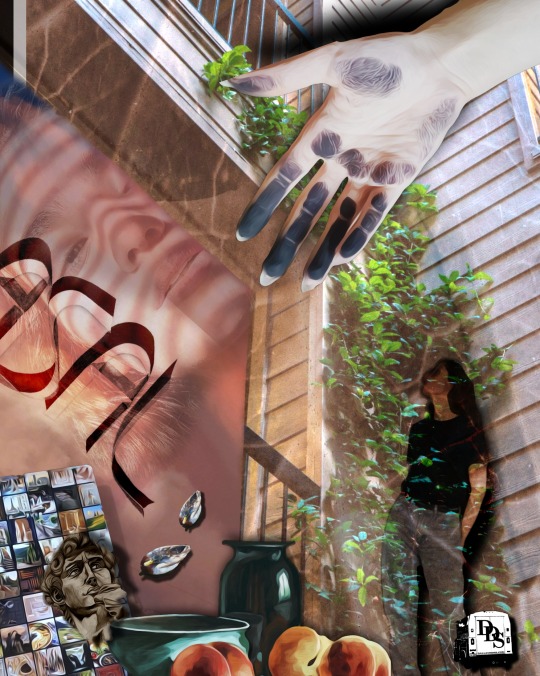
This photomontage was created using 12 photos of a Samsung Galaxy Note 10 and a Canon M50 Mark II. All of the images were captured by me, with some taken in the past. The included artworks are also my creations, and I used the solo growing plant photo from my "Visual Identity" post. I incorporated extensive blending and added effects to most of the images to make them look like paintings. The idea behind this photomontage was to show how my artistic hand, depicted with charcoal, can help me express my unorganized, random thoughts, represented by the images mostly on the left side. I employed various techniques such as blending, opacity changes, cutouts, artistic effects, and repetition. The DDS on the bottom right is also used as my signature, which was actually from a truck I took a picture of.
Canon EOS M50 Mark II - Natural lighting Samsung Galaxy Note 10 Camera - Natural lighting + Flash light
3 notes
·
View notes
Text
Reading 2: DADA & Photomontage
DADA was an avant-garde movement that emerged as a negative reaction to the horrors and absurdities of World War I. It was characterized by its rejection of the traditional values and norms of art and society, aiming to devalue established conventions through irrationality and nonsense.
DADA was rooted in the neutral environment of Switzerland but quickly grew into an international movement. DADA was anti-war, anti-bourgeois, and anti-art, embodying a state of mind rather than a specific style. It was an uprising against the cultural and intellectual conformity that had led to the war, emphasizing spontaneity, nonsense, and the irrational.
DADA artists expressed their ideas through various means, including absurd performances, irrational and fragmented poetry, and art that defied traditional aesthetics and meaning. Their works often involved satire, parody, and a deliberate embrace of chaos and randomness to challenge the existing social and artistic norms.
DADA's influence is evident in various modern and contemporary art forms, particularly in surrealism, performance, and conceptual art. The movement's legacy persists in the modern art world, where artists continue to explore themes of absurdity, challenge conventional aesthetics, and push the boundaries of what art can be.
Tristan Tzara, a founding figure of DADA, was known for his provocative poetry and manifestos that articulated the movement's anti-establishment ethos. Marcel Janco's chaotic and fragmented paintings and architecture embodied DADA's aesthetic. Hugo Ball, a poet and performer, was instrumental in founding DADA and establishing its theatrical and performative aspects through his elaborate sound poem recitations. Jean Arp's abstract sculptures and collages exemplified DADA's embrace of chance and irrationality. Hannah Höch pioneered photomontage, creating provocative and surreal collages that critiqued contemporary society and gender norms. Raoul Hausmann, a key figure in the Berlin DADA group, innovatively used photomontage to critique media and political propaganda. Marcel Duchamp's ready-mades, such as "Fountain," radically redefined art and challenged the notion of artistic authorship and creativity.
DADA artists, particularly through the use of photomontage, redefined the role and potential of photography. Hannah Höch and others used this technique to create new, surreal images by cutting and reassembling photographs. This method challenged the idea of photography as a mere tool for documentation and opened up new avenues for creative and critical expression. Their work demonstrated that photographs could be manipulated to convey complex and provocative messages, breaking away from traditional notions of visual representation.
0 notes
Text
Reading 1: Nature of Photographs - S. Shore
The physical prints add another layer to the meaning of the photograph. Being able to interact with a physical object, seeing where it begins and ends, is different from viewing something on a screen. It depends on what the artist is trying to convey; it might be more meaningful for the artist to represent their photos in a virtual fashion rather than physically. So yes, the meaning is different when the photo is displayed online or virtually. I personally believe that when a photo is important, it comes to the physical world rather than staying digital; therefore, physical photos have more thought and meaning behind them.
Observing is very important. Photography is the art of noticing small details around us that most ignore. The beauty of life is hidden in the simplest, smallest things around us. Some can see this, but others need guidance. Photography guides the eyes of the viewer to the beauties in life, things they generally overlook. I see very deeply and enjoy observing. This ability helps me notice the details and capture specific things that are hidden.
I agree with this approach. I believe it creates more meaning for the photos as it requires a thought process before taking and editing the picture. I believe it is important and requires thought to include specific things and exclude others. Filling the picture with attention has always been my approach to photography. Even before the editing process and cropping, I pay special attention to what is included in my photo. The elements in the photo should have harmony, but this depends on the purpose of the photography and the meaning the photographer is trying to convey.
1 note
·
View note
Text
EX. Editing
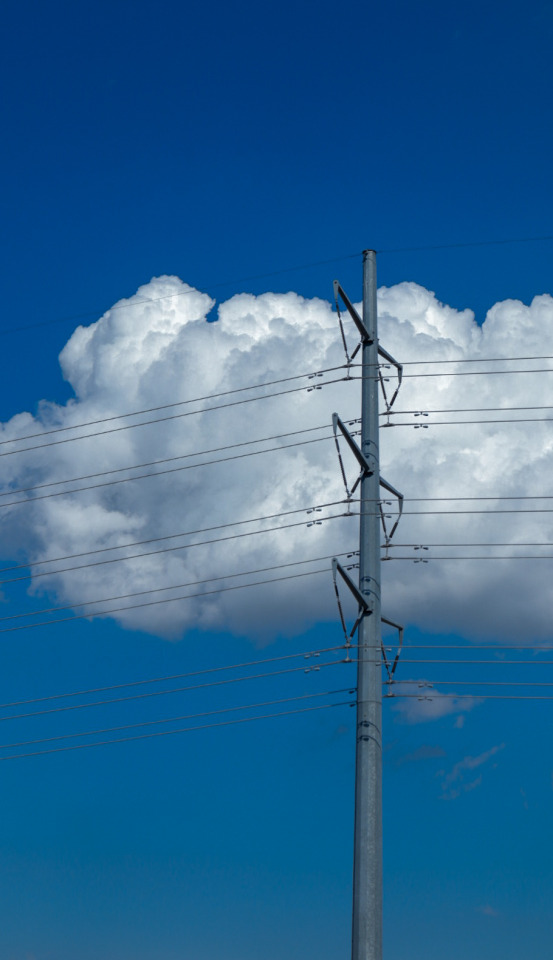

In the original photo, I simply reduced the exposure, increased the contrast, and added a little saturation. It looked like a typical scene of the sky, clouds, and an electricity pole. However, in the second photo, I experimented with different settings. I reduced the exposure, increased the contrast, and adjusted the tone and color using the curve tool. This resulted in a golden hue in the clouds and an overall golden tone in the photo. The second photo looks more dreamy and surreal. It also has a different crop, focusing only on the top of the pole and the clouds, creating a sense of magic rather than reality.
Canon EOS M50 Mark II - Natural lighting
5 notes
·
View notes
Text
3. Visualizing Identity
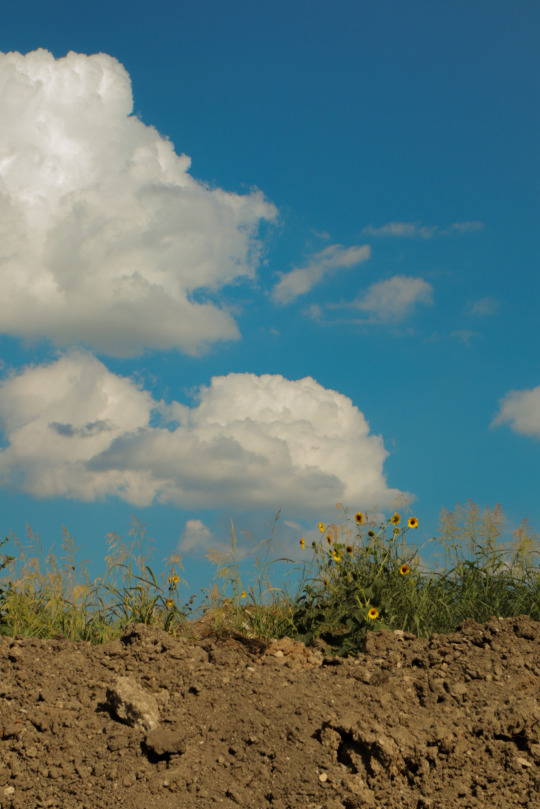
This photo represents the optimistic and social aspect of me. Despite the challenges in life and the difficulties we all go through, I strive to be optimistic and always have hope. The sand pile, made for construction, represents the challenges in life, while the flowers on top of it symbolize optimism and hope, growing amidst difficulties. The clouds in the sky represent peace; I tend to be a peaceful person and calm others as well. So, the flowers growing from dirt to clouds symbolize the journey from challenges to peace and brightness. The bright and saturated colors of the photo also represent the sociable aspect, happiness, and positivity.
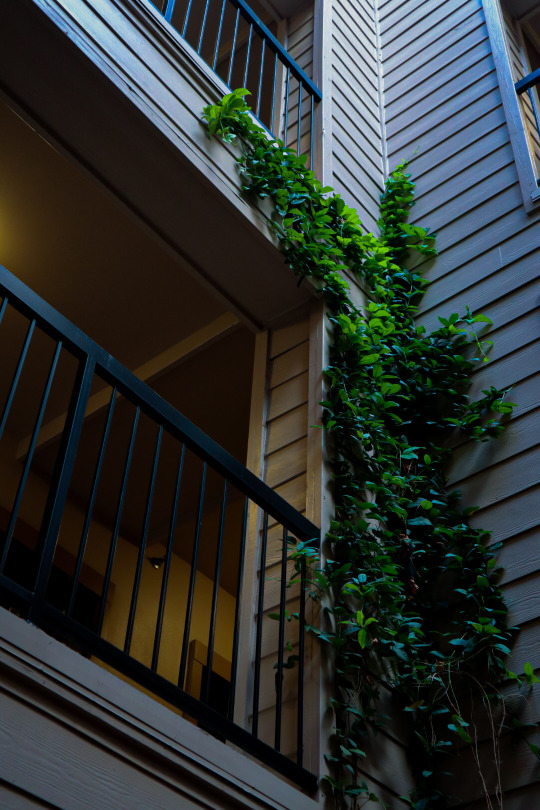
This photo, on the other hand, represents the introverted part of me. Although I enjoy being around people and being social, there are times when I prefer solitude, and I truly appreciate this solitude. I like spending time alone to work on my abilities, improve myself, and reflect on my personality. The plant growing in the apartment structure, alone without other plants, symbolizes this aspect of my personality. At the same time, I have a strong connection with nature, representing my interest in the natural world. The lighting in the photo is dim, with a cool temperature and high shadows. While this might be seen as sad, I find this gloomy atmosphere comforting and it represents the environment I create for myself when I am alone.
Canon EOS M50 Mark II - Natural lighting
2 notes
·
View notes